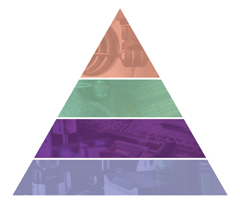Prozesseinrichtung
Die automatisierte Einrichtung mithilfe eines Messsystems kann bis zu zehnmal schneller als manuelle Einrichtverfahren sein.
Mit den Kontrollmechanismen der zweiten Stufe der Produktionsprozess-Pyramide (Productive Process Pyramid™), der Prozesseinrichtung, werden die Beziehungen zwischen der Maschine, dem Werkstück und den Werkzeugen vor dem Zerspanen festgelegt. Diese automatisierten, vorausschauenden Regelungen stellen sicher, dass alles auf Anhieb richtig läuft.
Damit beim Zerspanen von Anfang an nichts schief läuft

Die zweite Stufe der Pyramide, die Prozesseinrichtung, befasst sich mit Abweichungsursachen, wie beispielsweise Lage der Komponenten, Größe der Werkzeuge, Korrektur der Werkzeugmaschine, und stimmt die Bearbeitungsschritte auf die tatsächliche Position des Werkstücks ab.
Hierbei handelt es sich um vorbeugende Regelungen, die kurz vor der spanenden Bearbeitung zum Einsatz kommen.
Die Werkzeugeinrichtung ermittelt
- die Länge der Spindel-Nulllinie, um eine Höhenkorrektur festzulegen, und prüft, ob die Länge innerhalb der definierten Toleranz liegt
- den Drehdurchmesser, um das Maß für die Werkzeugkorrektur festzulegen
Die Werkstückeinrichtung ermittelt
- den Werkstücktyp für die Auswahl des entsprechenden NC-Programms
- die Position eines Bezugsmerkmals, um ein Arbeitskoordinaten-Bezugssystem (WCS) festzulegen
- die Größe der Rohlinge/Werkstücke, um Auf- bzw. Untermaße und die Sequenz der Schlichtbearbeitung festzulegen
- die Lage und Orientierung eines Teils (relativ zu den Maschinenachsen), um die Koordinatendrehung festzulegen
Die Maschineneinrichtung ermittelt
- die Ausrichtung der Drehachse, des Drehtisches oder der Spannmittel für die Positionierung und Aufspannung von Werkstücken
- die Position des Zentrums eines Drehtisches und/oder von Referenzpunkten an Spannmitteln
Vorbeugende Regelung
Die automatisierte Einrichtung mithilfe eines Messsystems kann bis zu zehn Mal schneller als manuelle Einrichtverfahren sein. Das gibt Ihnen mehr Zeit für das Spanen.
Darüber hinaus sind Messsysteme kalkulierbar - Sie werden genau wissen, wie lange die Einrichtung dauert und können entsprechend planen.
Die Einrichtung von Prozessen, die Messanwendungen direkt auf der Maschine nutzen, ist vollständig über Programme steuerbar. Fachkräfte müssen daher nicht mehr Messungen aufnehmen, Berechnungen anstellen und Korrekturwerte eingeben.
Die Messtaster zum Prüfen von Werkstücken, Werkzeugkontrollsysteme und die Productivity+™ Software von Renishaw sind für eine schnelle, automatisierte und wiederholbare Einrichtung von Routinen zur spanenden Bearbeitung unerlässlich.
Dokumente
-
 Broschüre: Messtechniklösungen für eine produktive Prozesskontrolle
Broschüre: Messtechniklösungen für eine produktive Prozesskontrolle
Verbessern Sie Ihre Leistungsfähigkeit
-
 White Paper: Der Bessere überlebt - Prozessüberwachung in der spanenden Bearbeitung
White Paper: Der Bessere überlebt - Prozessüberwachung in der spanenden Bearbeitung
In schwierigen Zeiten konzentrieren sich Hersteller auf die Reduktion ihrer Betriebskosten, können sich aber vielleicht nicht den Ausweg über den Erwerb produktiverer Maschinen leisten. Wie können Kosten radikal reduziert werden, ohne bestehende Maschinen zu ersetzen? In diesem Beitrag werden vier Bereiche analysiert, in denen sich erhebliche Einsparungen erzielen lassen wenn Unternehmen bereit sind, die Steuerung ihrer Bearbeitungsprozesse zu ändern.

